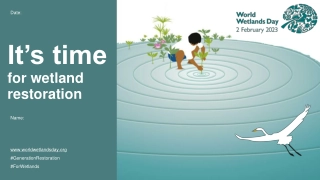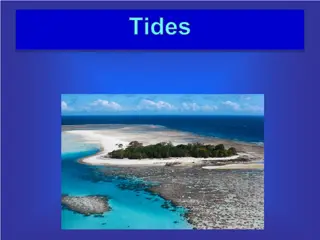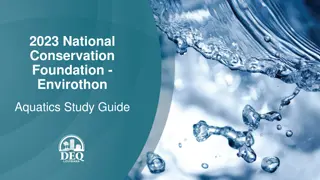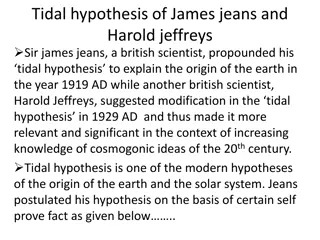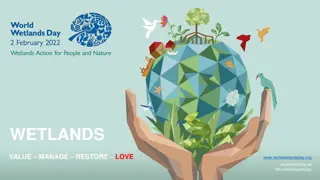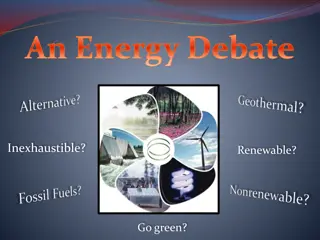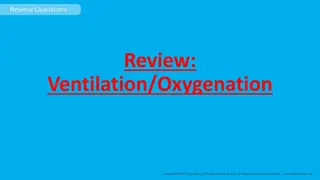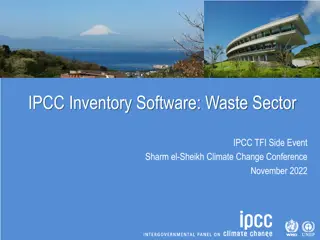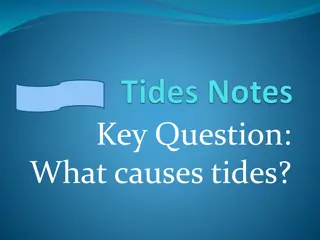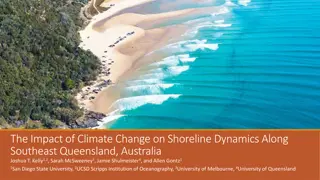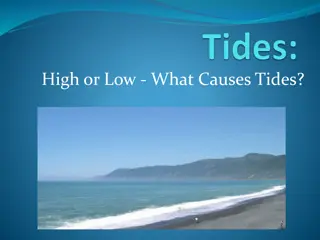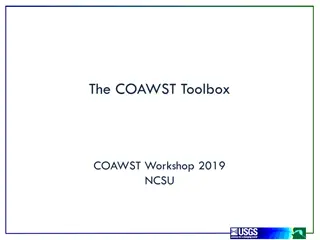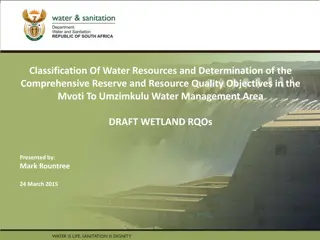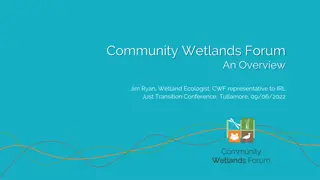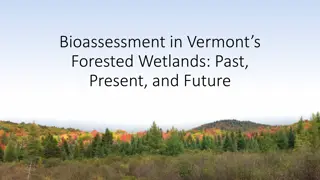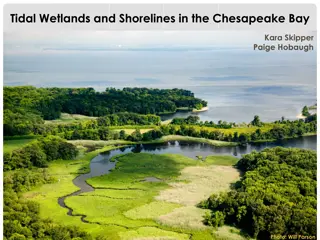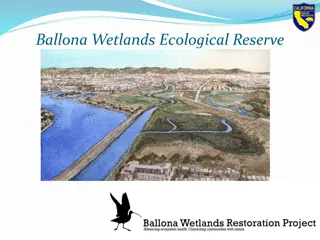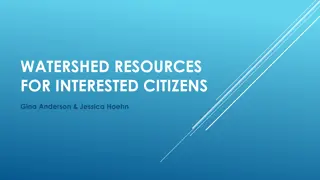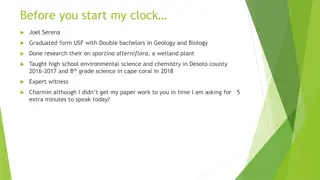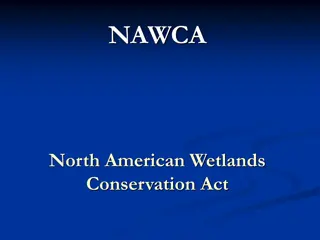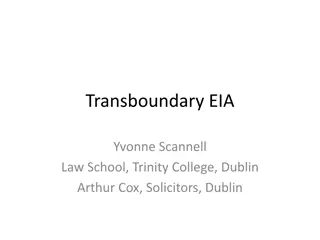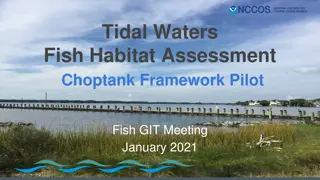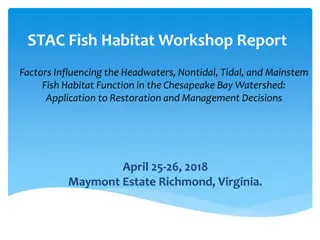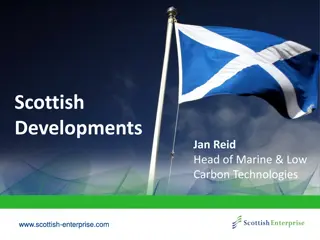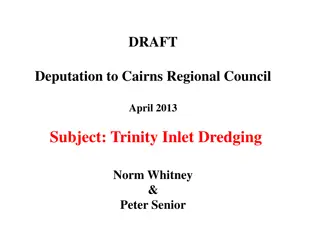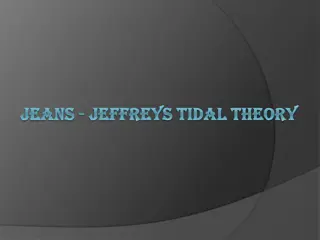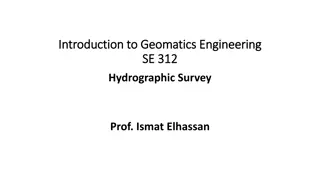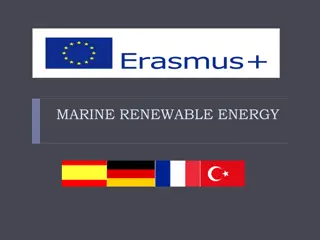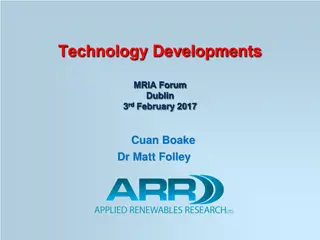Green Energy Market
Green energy also referred to as clean energy, is usually derived from natural sources that are constantly replenished. Solar energy, wind energy, hydroelectric power, biomass energy, geothermal energy, tidal energy, and wave energy are different types of renewable energy. Solar energy is the radian
6 views • 6 slides
Restoring Wetlands: Vital for Our Future
Learn about the importance of wetlands, the urgency of restoration, and best practices for the preservation of these critical ecosystems. Discover how wetlands support biodiversity, provide essential services to humanity, and can be restored through community involvement and sustainable practices.
3 views • 18 slides
Innovative Approach to Managing Environmental Challenges in River Catchments
A project led by John Bryden at Oxford University focuses on community modelling for rivers, enabling local people to use tools typically reserved for scientists. The initiative addresses issues faced by rivers through the INCA model, constructed wetlands, and community engagement. By creating wetla
9 views • 12 slides
Understanding Tides: Causes, Types, and Phenomena
Explore the fascinating world of tides, from what causes them to the daily cycle of high and low tides. Discover why the moon plays a significant role in influencing tides and how tidal currents contribute to the dynamic movement of ocean waters. Learn about the gravitational forces of the Earth, Mo
3 views • 30 slides
Modelling Estuarine Habitats in the Upper Sea Scheldt: Human-Induced Adaptations
Explore a research study on modelling estuarine habitats in the Upper Sea Scheldt under various human-induced channel and floodplain adaptations. The study examines the impact of interventions on habitat size, water quality, ecosystem, and more, providing insights into the future of the estuarine en
3 views • 13 slides
2023 National Conservation Foundation - Envirothon
Explore the intricate dynamics of aquatic ecosystems and wetlands conservation through this comprehensive study guide. Discover the importance of watersheds, the hydrologic cycle, aquatic food webs, energy flow at trophic levels, and common macroinvertebrates in Louisiana. Learn about different wetl
3 views • 27 slides
Understanding Tides and Earthquake Triggers
Spring tides occur when the moon is new or full, resulting in higher high tides and lower low tides. Neap tides follow, with moderate tides. Tides can trigger earthquakes due to stress and tidal components like normal and shear stresses. Statistical tests analyze the tidal phase angles at the time o
0 views • 25 slides
The Tidal Hypothesis of James Jeans and Harold Jeffreys: Origin of the Earth
The Tidal Hypothesis proposed by British scientists James Jeans and Harold Jeffreys in the early 20th century suggested that the Earth and solar system were formed from the interaction of the Sun and an intruding star. Jeans postulated that massive gravitational forces from the intruding star caused
2 views • 5 slides
World Wetlands Day 2022: Taking Action for Wetlands Conservation
World Wetlands Day is an annual event celebrated on February 2nd to raise awareness about the importance of wetlands for people and the planet. This year's theme, "Wetlands Action for People and Nature," emphasizes the urgent need for increased investment in the conservation of wetlands to ensure th
0 views • 12 slides
Understanding the Debate on Inexhaustible vs. Nonrenewable Energy Sources
The energy debate revolves around the classification of energy sources into nonrenewable, renewable, and inexhaustible categories. Fossil fuels, such as coal, petroleum, and natural gas, fall under nonrenewable sources due to their finite nature, while wind and tidal energy are examples of inexhaust
0 views • 18 slides
Understanding Ventilation and Oxygenation in Respiratory Care
Review covers key concepts of ventilation and oxygenation, including the control of breathing, assessment of tidal volume, and the roles of different respiratory centers. Learn about the importance of observing chest rise to assess tidal volume accurately. Gain insights into the brain stem's pivotal
6 views • 41 slides
IPCC Inventory Software Enhancements for Waste Sector Emissions Estimation
Explore the latest enhancements in the IPCC inventory software related to waste sector emissions estimation. Major updates include subnational disaggregation, Tier 3 methods, wetlands supplement, and improvements in worksheet structure and layout. The software allows for detailed estimation of green
1 views • 10 slides
Understanding Tides: Causes, Forces, and Patterns Explained
Explore the fascinating world of tides, from their causes - the gravitational forces of the sun and moon, to the concepts of tidal range, spring tides, and neap tides. Discover how these natural phenomena impact our oceans and environment in a rhythmic cycle of ebb and flow.
0 views • 11 slides
Impacts of Climate Change on Shoreline Dynamics in Southeast Queensland, Australia
The study focuses on understanding the influence of climate phenomena like ENSO, SAM, and STR on shoreline change along the wave-dominated coast of Southeast Queensland. Utilizing a shoreline dataset mapped over two decades, the research explores the variability in wave climate and its correlation w
3 views • 13 slides
Understanding the Causes of Tides and Their Effects on Earth
Tides are a result of the gravitational interactions between Earth, the Moon, and the Sun. The Moon's gravity creates tidal bulges on Earth's surface, leading to the daily rise and fall of water levels known as tides. These phenomena have a significant impact on ocean coastlines and the overall wate
0 views • 16 slides
Overview of the COAWST Toolbox and its Components
The COAWST Toolbox is a suite of MATLAB tools, scripts, and functions that offers standard functionalities for creating grids, initial conditions, atmospheric forcing, boundary conditions, and climatology files for COAWST. It includes tools for creating tidal forcing files, and ROMS expects specific
0 views • 51 slides
Surface Water-Groundwater Interactions and Nitrogen Cycling in a Tidally Influenced River Study
Study on the dynamic interactions between surface water and groundwater in a tidal river, focusing on nitrogen cycling. The research highlights the impact of tidal fluctuations on bank storage, nitrogen transformation, and nutrient cycling. Findings suggest that river discharge affects the exchange
1 views • 16 slides
Insights into Neutron Stars: Observations and Implications
Exploring the fascinating realm of neutron stars through astronomical observations and the implications for equations of state (EOS). Delve into the mysteries of neutron star properties, measurement results from projects like PREX/CREX, and the significance of NS masses, tidal deformabilities, and r
0 views • 24 slides
Comprehensive Water Resource Classification and Management in Mvoti to Umzimkulu
This presentation discusses the assessment and management of wetlands in the Mvoti Water Management Area through the establishment of Resource Quality Objectives. It highlights the importance of wetlands, key strategies for wetland management, and the prioritization of wetland conservation efforts b
2 views • 21 slides
Community Wetlands Forum Overview by Jim Ryan, Wetland Ecologist
The Community Wetlands Forum, represented by Jim Ryan, is a platform promoting community-led wetland conservation in Ireland. With a focus on biodiversity, conservation, and community well-being, the forum aims to foster collaboration, knowledge sharing, and inclusive participation among stakeholder
0 views • 10 slides
Bioassessment in Vermont's Forested Wetlands: Monitoring and Conservation Efforts
Vermont's Wetlands Program, part of the Department of Environmental Conservation, actively monitors and assesses the health of the state's wetlands. Utilizing bioassessment methods, they aim to support planning, regulatory activities, and restoration projects while tracking long-term trends in wetla
0 views • 17 slides
Tidal Wetlands and Shorelines in the Chesapeake Bay: Environmental Impact and Conservation Efforts
Tidal wetlands and shorelines in the Chesapeake Bay face pressures from water, land, storms, upland development, shoreline modification, and sea-level rise. Collaborative efforts like the Fish Habitat Action Team aim to highlight the importance of these ecosystems for fisheries. Projects focus on sy
0 views • 9 slides
Aquatic Treatment Systems for Wastewater Reclamation and Reuse
In aquatic systems, wastewater treatment involves bacterial metabolism and sedimentation, with aquatic plants playing a role in improving treatment capabilities. This article discusses the functions of aquatic plants in treatment systems and the categories of wetlands used for wastewater treatment,
1 views • 15 slides
Conservation Efforts and Restoration Plans for Ballona Wetlands
The Ballona Wetlands Ecological Reserve is undergoing long-term restoration planning to restore tidal circulation, provide diverse wetland habitats, and create new habitat areas for native species. Various initiatives and projects, such as the Dutch Slough Carbon Sequestration and the EIR Project Go
1 views • 15 slides
Watershed Resources for Interested Citizens
Explore a variety of resources related to watersheds, wetlands, and water monitoring, including tools provided by the U.S. Fish and Wildlife Services National Wetland Inventory. Learn about different types of wetlands, access the Indiana Watershed Group Finder for locating hydrologic unit codes, and
3 views • 18 slides
Protecting Wetlands: A Call to Deny Agricultural Rezoning
Joel Serena, a Geology and Biology graduate, urges the board to deny agricultural land rezoning based on environmental factors. Through images and compelling arguments, the detrimental effects of mining on wetlands like Horse Creek in Florida are highlighted. The plea is to safeguard existing sustai
0 views • 21 slides
North American Wetlands Conservation Act (NAWCA) Overview
The North American Wetlands Conservation Act (NAWCA) is a federal funding program established to protect and restore wetlands in North America. Through Joint Ventures, partners access funds for various projects across the region, with grants available for both standard and small projects. The act re
0 views • 15 slides
Transboundary Environmental Impact Assessment for Greenstar Development
The Transboundary Environmental Impact Assessment (EIA) conducted for the Greenstar Development project involving EU Member States A and B reveals potential environmental impacts like soil and waste deposition, polluted dredging material transfer, and altered currents affecting wetlands and flooding
0 views • 7 slides
Coastal Ecosystems: Salt Marshes and Mangroves Overview
Explore the factors influencing coastal ecosystems like latitude, tidal cycles, wave energy, and geological characteristics. Dive into examples from the Pacific Northwest and southeastern U.S., focusing on salt marsh ecosystems. Learn about plant communities and zonation in salt marsh environments.
0 views • 22 slides
Empowering Communities for Wetlands and Bog Restoration Through Community Involvement
Empowering local communities for wetlands and bog restoration involves educating on the benefits of conservation, navigating through political challenges, and fostering community involvement. The Wetlands Forum and local networks aim to engage stakeholders in identifying potential sites and organizi
1 views • 12 slides
Tidal Waters Fish Habitat Assessment Choptank Framework Pilot Fish GIT Meeting January 2021
The Tidal Waters Fish Habitat Assessment Choptank Framework Pilot Fish GIT Meeting held in January 2021 discussed background, drivers, and the selection of the Choptank River as a candidate tributary. The project team, responsible parties, actions, and timeline for developing an analytical framework
0 views • 17 slides
Factors Influencing Fish Habitat in Chesapeake Bay Watershed Workshop Report
This workshop report delves into the factors affecting fish habitat function in the Chesapeake Bay Watershed, focusing on headwaters, nontidal, tidal, and mainstem areas. It outlines the workshop process, assessment frameworks, and user needs to support restoration and management decisions. The repo
1 views • 31 slides
Scottish Energy Developments and Innovation in Marine and Low Carbon Technologies
Scotland's energy sector is pioneering climate-friendly initiatives towards decarbonization by 2030. The focus lies on supporting renewable energy sources, enhancing energy system flexibility, efficiency, and resilience, and promoting the marine sector's advancements in tidal energy projects. The co
0 views • 11 slides
Maximizing the Value of Dredging Spoil in Trinity Inlet
Proposed dredging in Trinity Inlet raises concerns about spoil disposal; suggests utilizing dredged spoil for land-based projects instead of dumping at sea. Explores potential benefits of dredged spoil for Cairns economy and community. Recommends considering dredging more than the minimum amount to
1 views • 14 slides
Understanding Jeans-Jeffreys Tidal Theory of Planet Formation
Tidal Theory posits that planets form from condensed materials close to the sun, a concept pioneered by Sir James H. Jeans and Sir Harold Jeffreys. Jeans proposed continuous matter creation in the universe, while Jeffreys explored the solar system's origin and latitude variation through astronomical
0 views • 5 slides
Understanding Hydrographic Surveying in Geomatics Engineering
Hydrographic surveying is a specialized field within geomatics engineering focused on mapping the water floor to produce nautical charts or bathymetric maps. These surveys play a crucial role in navigation, pipeline routing, cable installation, and more, providing essential data for various applicat
0 views • 19 slides
Tidal Deformability of Compact Stars Admixed with Scalar Fields Research Summary
Researchers like C. J. Horowitz and Kwing-Lam Leung are exploring the effects of dark matter, scalar fields, and ultra-light dark matter on compact stars like neutron stars. Methods involve calculating tidal love numbers, using energy-momentum tensors, and studying equilibrium solutions. The study a
0 views • 20 slides
Exploring Dark Matter in Neutron Stars
Investigate the interaction of dark matter within neutron stars, comprising approximately 25% of the universe's total matter. The nature of dark matter assumptions, its distribution within neutron stars based on fermionic or bosonic properties, and the implications for self-interacting fermionic and
0 views • 22 slides
Understanding Marine Renewable Energy and Tidal Power
Renewable energy is derived from natural resources that won't run out. Tidal energy harnesses the rise and fall of water levels due to tidal waves, occurring typically twice a day with a 12-hour cycle.
0 views • 9 slides
Advancements in Marine Renewable Energy Technology: A Comprehensive Overview
Cutting-edge developments in marine renewables, particularly tidal energy, are showcased in this event report. The profile highlights the extensive experience of key figures in the field, detailing projects like Tandem Tidal Turbine and ADCP applications. The research dissemination on tidal turbine
0 views • 12 slides

